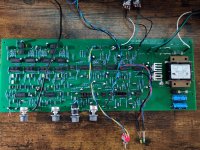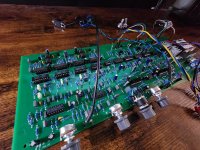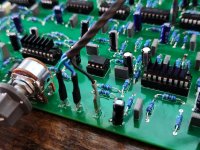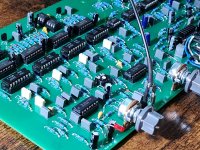Exactly. These act as amplitude modulatores - replacing them would require a full re-design. Not a good idea without exactly understanding the original.TDA1074A is/was a four gang voltage controlled voltage divider. In the CLS222 they acted like a VCA, as far as I can see it. Hence, they cannot be replaced by some common mechanic potentiometers.
Best regards!
Indeed.Exactly. These act as amplitude modulatores - replacing them would require a full re-design. Not a good idea without exactly understanding the original.
I may have found a reliable bulk source for these chips. If that works out I'll snag a bunch and press on with the current format.
Small update to show I mean business.
I believe I've found promising sources for the TDA chips, orders have been placed.
I'm going to do a replica of the CLS-22 as my base-line since it's more barebones (no relays & additional rectified supply). This is more possible thanks to the detailed photos provided on the web and also the kind fellow with an original unit who had offered to assist. Once the proto is verified I can begin working in alternatives and work on my own layout with choice of modern parts. If all goes well I'll offer PCBs for both versions.
That being said, if anyone knows of possible errors in the schematics available please feel free to share notes.
Thanks!
I believe I've found promising sources for the TDA chips, orders have been placed.
I'm going to do a replica of the CLS-22 as my base-line since it's more barebones (no relays & additional rectified supply). This is more possible thanks to the detailed photos provided on the web and also the kind fellow with an original unit who had offered to assist. Once the proto is verified I can begin working in alternatives and work on my own layout with choice of modern parts. If all goes well I'll offer PCBs for both versions.
That being said, if anyone knows of possible errors in the schematics available please feel free to share notes.
Thanks!
Had some spare time over vacation last week. Couldn't help myself 😀Nice. You put that together pretty fast!
BTW - errors found in the original CLS-22 schematic were:
I022 - pins 6 & 7 should be connected as well as pins 12 & 14. The schematic is missing dots showing they're connected just as the other 3 blocks are.
I022 - channel pins 15, 16 & 17 and channel pins 2, 3 & 4 should be swapped.
R161 & C108 positions should be swapped.
R162 & C109 positions should be swapped.
Last edited:
Thank you! And yup. It's pretty close to being 1:1 against the original. Electronically it's all the same. Biggest differences are the use of modern parts where possible - all film caps have 5mm lead spacing, new power transformer, wire jumpers are now traces (it's a 2-layer board) and also smoothed out the traces avoiding 90° angles (more of a personal preference). I've also included a ground tab for proper grounding from the AC receptacle. Everything else is per the original.I'm very impressed, too 👍! Did you design the PCB using the original chips?
Best regards!
I'll keep being switched to this thread with excitement! Alas, I only have one TDA1022 BBD chip laying in my drawers 🙄 ...
Anyway, I'm wondering why Dynacord didn't use the SAD1024A BBD as in the Echolette ME IV E/Dynacord DC 300 E Leslie wannabees which is twice as long as the TDA1022 .
Best regards!
Anyway, I'm wondering why Dynacord didn't use the SAD1024A BBD as in the Echolette ME IV E/Dynacord DC 300 E Leslie wannabees which is twice as long as the TDA1022 .
Best regards!
Just because it was less expensive, and for this effect you do not need that much delayI'll keep being switched to this thread with excitement! Alas, I only have one TDA1022 BBD chip laying in my drawers 🙄 ...
Anyway, I'm wondering why Dynacord didn't use the SAD1024A BBD as in the Echolette ME IV E/Dynacord DC 300 E Leslie wannabees which is twice as long as the TDA1022 .
Best regards!
Both the ME IV E and DC 300 E (which are identical, btw.) are two channel wannabees. One channel drives a static 15" woofer and a piezo horn, the other one drives a (now obsolete) RCF TW100 compression driver that shouts into a mechanical »Spacesound« tremolo/chorale unit from Italy. The SAD1024A belongs to the static channel. Hence, I have some difficulties to get why in this unit a longer delay time than in a complete simulation machine as the CLS222 might have been obligatory?
Best regards!
Best regards!
That makes sense. As for single channel 512 stage BBDs goes, at the time the SAD512 and the MN3004 would have been good candidates and would even provide less distortion. Just speculating here, with the TDA1022 being somewhat new to the scene as a sub-par alternative they would have offered them at competitive prices.Just because it was less expensive, and for this effect you do not need that much delay
Also, back then procurement was based on what you can get through local distributors and mail-order catalogs. So perhaps it was case of being stricken to what was available locally at the time.
Also, the SAD1024 was dual channel. Having not looked at the schematic of what you're referencing, it is possible each channel was used independently or even in series in a parallel multiplexed fashion for twice the sample rate (like the ADA flanger). Those chips can also handle higher frequencies which would effectively do the same thing if one were wired in series (same delay time, twice the sample rate) although would possibly exacerbate complications with heterodyning which is why most designs avoid requiring those higher frequencies.
Last edited:
I bought the chip I still own for a Elektor project that never came to fruition in the 1970ies. I paid more than DM 20 for it which was quite some money then, not only for me as a poor pupil 😉 . I don't know the contemporary prices for a SAD512 or 1024, though....with the TDA1022 being somewhat new to the scene as a sub-par alternative they would have offered them at competitive prices.
Best regards!
Well now I don't feel so bad about what I had to pay for 4 of them today. But I'm also ignorant about foreign currency and inflation - especially on how it was >40 years ago.I bought the chip I still own for a Elektor project that never came to fruition in the 1970ies. I paid more than DM 20 for it which was quite some money then, not only for me as a poor pupil 😉 . I don't know the contemporary prices for a SAD512 or 1024, though.
Best regards!
You had bought that TDA1022 over a decade before I was born. I didn't even know they existed that long ago but I see a datasheet stamped 1975.
With over 350 components it sure will be a fun one to assemble. I've got an interactive build guide ready to go which will be very helpful.I must say, populating that board looks like it would be a lot of fun
PCBs and final parts were ordered yesterday. Looking like I'll have the first one tested by next weekend. Fingers crossed!
Nice! Some remarks/questions: When you add the effect at 0:25 and also later on, some 3rd harmonics appears. Is this intentional? And in comparison with the real thing, i. e. a mechanical Leslie speaker, tremolo speed is way too fast.
Best regards!
Best regards!
- Home
- Live Sound
- Instruments and Amps
- Dynacord CLS 222 Leslie Simulator clone



